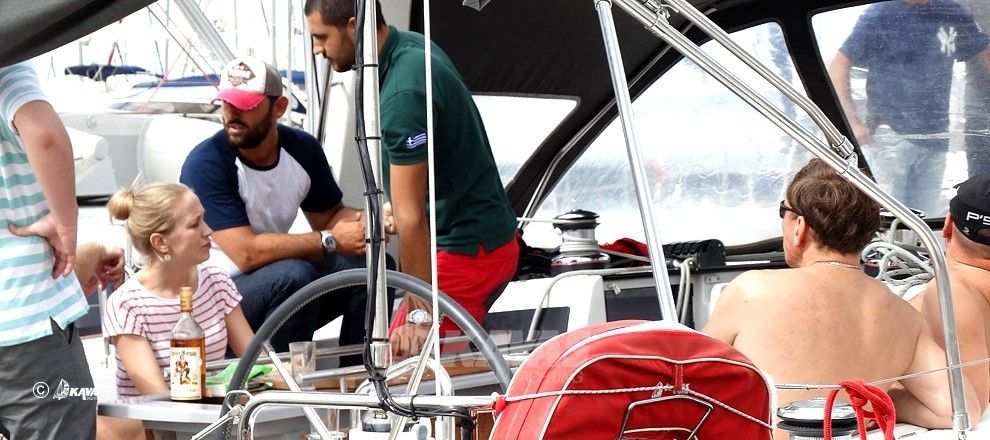Essential yacht and safety briefing checklist on a boat
Pre-Cruise briefing
In this article, 'Essential Yacht and Safety Briefing Checklist on a Boat,' the content focuses on the information that the skipper needs to provide to the bareboat rental crew.
The goal is to ensure that everyone is aware of how to act, especially in critical situations, because accidents can easily happen during our journey.
Tips for the skipper are provided in another article within this blog under the title: 50 Bareboat Charter Tips, for 2024.
So, before we embark on a bareboat sailing adventure, creating a cohesive and well-prepared crew is paramount.
Especially in the case of bareboat charter rentals, attention to everyone's well-being is key.
Prioritizing Crew Well-being
As we prepare for our voyage, it's important to be mindful of any special medical needs or allergies within the crew.
Your health and comfort are top priorities, and having a collective awareness will enable us to plan effectively, especially concerning provisions and meal preparation.
Comprehensive Crew Briefing
The skipper, is crucial to gather all crew members in the cockpit and effectively convey the necessary information to prevent or address unpleasant, and potentially hazardous situations during the voyage.
Everyone should be aware of the location, usage, and emergency procedures related to the survival and safety equipment on board.
Clear and concise explanations should be provided to ensure that each crew member understands how to act in case of an emergency.
This briefing should cover the essential aspects of the equipment, fostering a sense of preparedness and ensuring the safety of all on board.
The following list comprises essential safety and operational aspects for sailing
Man Overboard Procedures
Protocols and actions to be taken in the event of a crew member falling overboard.
First-Aid Kit
Onboard medical supplies and equipment to address minor injuries or emergencies.
Fire Extinguishers and Blankets
Urgent Danger! Remember the Fire Triangle?
Identification and usage of fire-fighting equipment, encompassing fire extinguishers and blankets for immediate response.
Survival
Guidance on essential survival gear, including details on the location, use, and deployment of life jackets for personal safety, and instructions on accessing and using the life raft for emergency evacuation.
VHF Use / Distress Signals
Utilizing VHF radio for communication and understanding distress signals for emergency situations.
COLREGS
Guidelines outlining the rules and responsibilities of vessels to prevent collisions (International Regulations for Preventing Collisions at Sea).
EPIRB
Overview of the Emergency Position Indicating Radio Beacon (EPIRB), emphasizing the importance of everyone knowing how to activate it in case of an emergency to signal distress and alert rescue services.
Safety Briefing in the Galley
Transitioning to the galley, crew members will be briefed on potential gas hazards, fire safety precautions, including safe practices while cooking (e.g., frying), and instructions on operating the stove's fire button and oven.
Heads Usage and Shower
Comprehensive Guide to Onboard Facilities: Heads (toilettes) usage and bilge button Instructions for Shower Safety
Safeguarding Cabins
Importance of Closing Hatches for Sea-Worthy Sailing
Engine's Basic Operation
Understanding the fundamental operation of the engine and the emergency shut-off procedure.
Lines, Winches, and Clutches
Introduction to sail-handling equipment, such as lines (ropes), winches for mechanical advantage, and clutches for securing lines, with emphasis on safe usage, including proper techniques to protect fingers when operating winches.
Mooring & anchoring procedures
Explain the safe working practices during mooring and anchoring operation
Also:
Caution Against Walking Barefoot on deck, for Injury Prevention
Sun Safety Advisory Hats & Sun Oil for Protection on Deck
Remind people to keep their heads below the boom on the coach roof when on a downwind run.
In any decent seas or after sundown that everyone shall wear a harness and be clipped on as soon as they leave the cockpit for the coach roof or foredeck.
Your three minute briefing
You may have chatted for a minute or a little more on each of the points above.
Every day thereafter you give the three minute, three point safety briefing before casting off.
Final thoughts
Sailing is very like life ashore in so many ways. There will be highs and fun times. There will be challenges and lows. The most successful people in this world claim they have deep reserves of self-reliance to which they will reach in a variety of situations.


